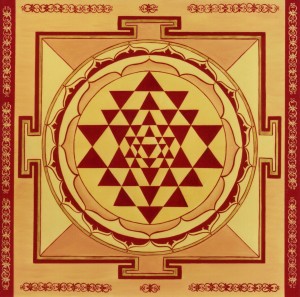
10 Oct Yantra Mantra Tantra
I’ve been experimenting with using yantras during my morning meditation practice lately. As visual tools, yantras can help center you during meditation. They also serve in meditation as symbolic representations of the energy pattern of a deity as seen by Tantric seers in their vision.
The word yantra is used in two or more ways in Sanskrit. It comes from the root “yam”, which means supporting or holding the essence of an object or concept. The syllable “tra” comes from “trana” or liberation from bondage, (love that part)! Yantra also means liberation from the cycle of birth and rebirth (moksha). As a tool, yantra meditation is used to withdraw consciousness from the outer world, so as to help the practitioner to go beyond the normal framework of mind to the altered states of consciousness known as turiya.
Yantras that represent any form of the divine mother are called Shakta Yantras. Yantras can also be related to Vishnu or Shiva. In most cases their forms are equal to some of the Shakta Yantras, but the colors differ. When working with a yantra, a mantra is needed to invoke the vital life force (prana) of the particular deity. A mantra is an invocation, containing a sacred syllable or set of syllables. When a mantra is uttered with specific rhythm, with sincerity of devotion and purity of thought and action, and with phonetic and grammatical accuracy, it is believed to invoke a particular deity and compel the deity to assist the invoker to achieve a desired end.
Tantra is the systematic use of the body and the mind as the physical instruments of divine realization. The body and the mind constitute the lower self and together they aim to indulge in the desire oriented actions of the lower self to perpetuate the interplay of the three gunas, specifically, sattva, rajas and tamas. According to Hindu scriptures, the transformation of the body and the mind are the most difficult part of one’s spiritual journey and that most of our difficulties on the path come because of our inability to deal with this problem successfully.
Tantra is therefore a very important and integral part of Hindu spiritualism and equally maintains its place in the ritual part of the religion. Practitioners of tantra combine the universal pattern of the yantra with the cosmic sound of a mantra to achieve a higher state of awareness, in which individual being and universal being are one. The dichotomy of the hemispheres is resolved, both are calm.
Generally speaking, we are more left hemisphere dominated and are lacking in right hemisphere education which causes some loss of imagination and of faith in higher values. Right hemisphere education through art, dance and music can help to restore the balance. By coloring and drawing the geometrical yantra diagrams, based on the mathematical perfection of sages of the East, we can make both of our hemispheres work simultaneously and calmly, achieve faith and look to live in constant awareness.
When a mantra is chanted according to the proper tantra, it is said that the sound vibrations gather force from the yantra and after reflecting from its surface, spread out into the universe and reach the deity. Definitely something to stick with on your spiritual journey!


